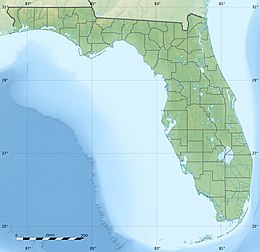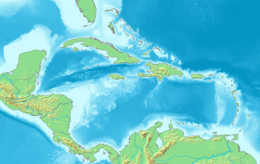 Satellite image of Duck Key and Toms Harbor Keys | |
| Geography | |
|---|---|
| Location | Gulf of Mexico |
| Coordinates | 24°46′13.8″N 80°54′42.4″W / 24.770500°N 80.911778°W |
| Archipelago | Florida Keys |
| Adjacent to | Florida Straits |
| Administration | |
| State | Florida |
| County | Monroe |
Duck Key is an island in Monroe County, Florida, United States, in the middle Florida Keys. It is part of the Duck Key, Florida census-designated place. The CDP also includes the neighboring island of Conch Key.

History
[edit]The key was the site of a salt manufacturing operation in the 1820s & 1830s. Occupation of the island ceased after the Labor Day Hurricane of 1935 and did not resume until the key was connected to the highway by a causeway in 1953. J.W. Norie, in his Piloting Directions for the Gulf of Florida, The Bahama Bank & Islands (1828) states: "Duck Key - Some two miles (3 km) long, low, rocky, & covered with mangroves; some small patches of good land with a little timber. This island formerly saltworks but they were transferred latterly to Key West, owned by Mr. Howe, who is also possessor of this Key." Hawk's Cay Resort is currently located here, and the island is sometimes known by that name.[1] Noted Michigan Senate leader, Emil Lockwood,[2] retired in Duck Key, where he served in many civic and political capacities until his death in 2002.[3]
Geography
[edit]Duck Key is located oceanside of U.S. 1 (or the Overseas Highway), at approximately mile marker 61, between Conch Key and Grassy Key.[4]
References
[edit]- ^ Florida Keys Gazetteer Archived May 17, 2008, at the Wayback Machine
- ^ MAN IN MOTION: Michigan's Legendary Senate Majority Leader, Emil Lockwood by Stanley C. and Marilyn H. Fedewa (Llumina/MSU Press, 2003)
- ^ "An Information Guide to Duck Key in the Florida Keys (Archives)". Duckkeyonline.com. Retrieved 7 October 2013.
- ^ "US Gazetteer files: 2010, 2000, and 1990". United States Census Bureau. 2011-02-12. Retrieved 2011-04-23.


Well, that’s interesting to know that Psilotum nudum are known as whisk ferns. Psilotum nudum is the commoner species of the two. While the P. flaccidum is a rare species and is found in the tropical islands. Both the species are usually epiphytic in habit and grow upon tree ferns. These species may also be terrestrial and grow in humus or in the crevices of the rocks.
View the detailed Guide of Psilotum nudum: Detailed Study Of Psilotum Nudum (Whisk Fern), Classification, Anatomy, Reproduction